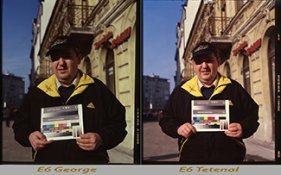Hi everybody!
Have been experimenting with maskless negative film for some while now, Rollei CN200, to see if I can make some sort of slides in C41 chemicals. I tried both to record inverted images off screens onto the film as well as to contact-print other negative films.
Both ways work if you play around with color balancing, actually the results are not so bad.
But unfortunately the CN200 is not clear at all, it has a quite grayish mask and this prevents the results from being useful for any projection.
Does anyone of you know if there is a way to get rid of the gray color? I tried much longer bleaching (helped a bit, but did not make the film clear). I've seen some others using the Washi X, a second maskless film, but I think this is yet again the same Agfa film that is used for the CN200, AGFA ASP 400X?
Does anyone know of any other maskless films for C41, the only other idea I have would be to use expired Kodak Vericolor Slide Film S0-279, which creates slides in C41.
Bernhard
Have been experimenting with maskless negative film for some while now, Rollei CN200, to see if I can make some sort of slides in C41 chemicals. I tried both to record inverted images off screens onto the film as well as to contact-print other negative films.
Both ways work if you play around with color balancing, actually the results are not so bad.
But unfortunately the CN200 is not clear at all, it has a quite grayish mask and this prevents the results from being useful for any projection.
Does anyone of you know if there is a way to get rid of the gray color? I tried much longer bleaching (helped a bit, but did not make the film clear). I've seen some others using the Washi X, a second maskless film, but I think this is yet again the same Agfa film that is used for the CN200, AGFA ASP 400X?
Does anyone know of any other maskless films for C41, the only other idea I have would be to use expired Kodak Vericolor Slide Film S0-279, which creates slides in C41.
Bernhard





